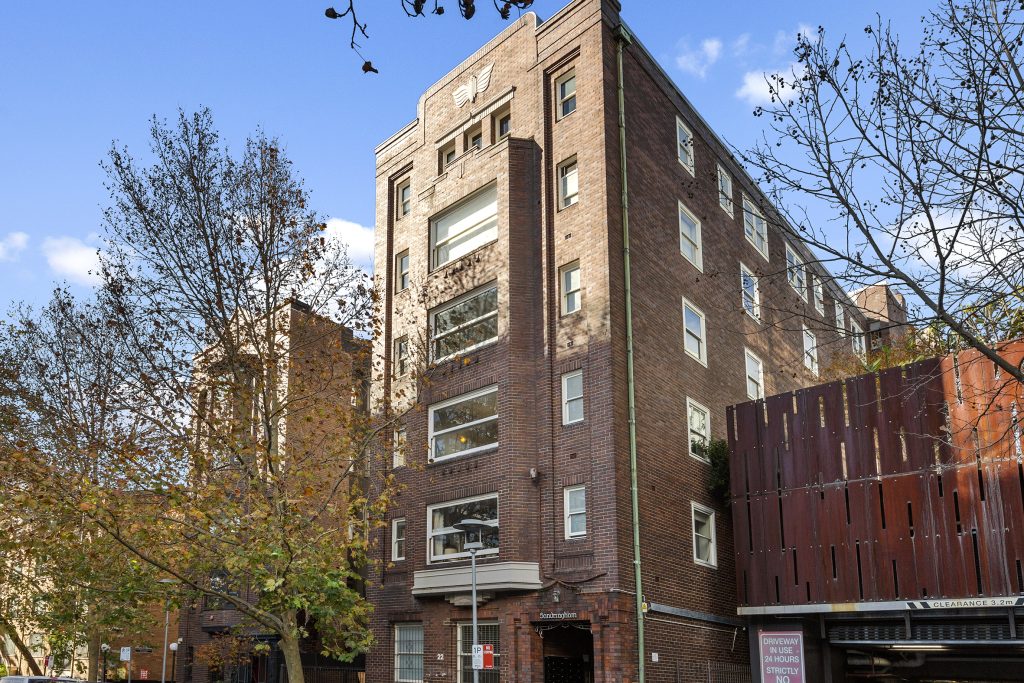SANDRINGHAM 20-22 SPRINGFIELD AVENUE POTTS POINT

The Sandringham apartments at 20-22 Springfield Avenue Potts Point is one of Claud Hamilton’s signature Art Deco apartment blocks, built circa 1935.
Apartment 26 is for sale through Penny Timothy and Luke McDonnell https://www.rwebay.com.au/7898571/
Mr Hamilton (1891-1943) was prolific in the Potts Point and Darlinghurst areas and lived locally in Elizabeth Bay. He was also the inventor of plastic cement and built many other apartment blocks in the area including the Savoy (1919), 10 Hardie Street, Darlinghurst, “St John’s Flats” (1916), 241 Darlinghurst Road, “Kenilworth” (1920), 18-22 Hardie Street, 235 Victoria Street (1923), “Tennyson House” (1924), 1 Farrell Avenue, “Normandy” (1926), “Versailles” (1929), 233 Darlinghurst Road, “Springfield Inn” now known as Funk House (early 1930), 23 Darlinghurst Road “Kaloola” (1927), 1 St Neot Avenue, “Byron Hall” (1928), 97 Macleay Street, “Wiringulla” (1927), 2 St Neot Avenue, “Lakemount” (1933), 46 Roslyn Gardens, and “The Tavern” (1940), 76 Elizabeth Bay Road.
He also designed properties in Lithgow, the Blue Mountains and “Arawua” (1935), at 6 Palm Beach Road, named after the Arawua Plains, where he was raised in New Zealand.
His King Street offices must have been very busy.
Hamilton was known in media at the time as a “renowned architect of the day”.
All his buildings reflected the neo-classical and Art Deco styles prolific at the time.
Sandringham with its liver-coloured brickwork has numerous Art Deco and neo-classical features including the winged escutcheon on the parapet of the façade, a reference to the Greek God Nike, the winged goddess of victory.
The interior of apartment 26 includes smart stratified skirting boards, chamfered architraves and herringbone parquet floors.
In 1927 Claud Hamilton ran into financial difficulties and took legal action. He settled the case successfully for £137/10, money owed to him to recover his costs against a real estate agent, Vincent Morgan, for unpaid work on a proposed block of apartments at Baden Street, Coogee.
But in 1940 Smith’s Weekly reported he owed £50 to Sydney Council and had failed to pay. Council petitioned for his bankruptcy in November 1940 and won the case.
He was then legally bankrupt.
Within three years on 22nd May 1943 the Sydney Morning Herald reported he had died aged 53.
It reported that “A Sydney architect, Mr. Claude Hamilton of Elizabeth Bay, died yesterday after a long illness. He was well-known as the inventor of a plastic cement building material and built a large number of houses at Lithgow of this material. Mr Hamilton supervised for Australian Consolidated Industries in a number of its constructions, and designed and constructed a large number of flats at Kings Cross.
He is survived by Mrs. Hamilton, three daughters and a son.”
Mr Hamilton left a lasting and distinct architectural legacy on our area.
By Andrew Woodhouse
Heritage Solutions





